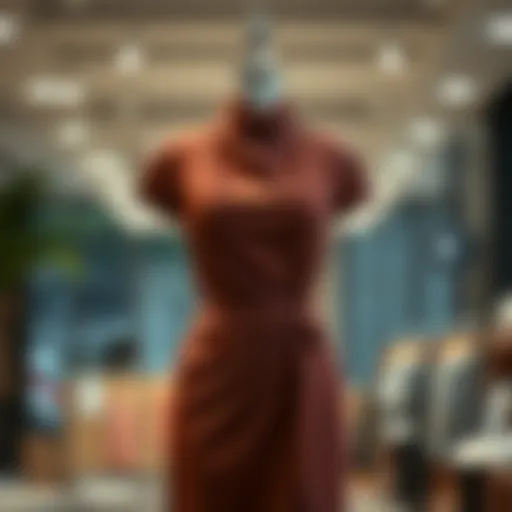Stylish and Functional Outfits for Petite Teachers


Intro
In the vibrant world of education, teachers play a crucial role, shaping young minds while also showcasing their unique style. For petite teachers, the task can be a bit tricky. Balancing professionalism with personal flair often comes down to understanding what works best for their frame. Styling your wardrobe doesn’t mean sacrificing comfort or appropriateness, especially in a bustling classroom environment. Here, we explore how petite educators can effectively curate their outfits to reflect their individuality while maintaining a polished appearance.
Fabric Knowledge
Understanding fabrics is vital for petite teachers looking to make informed choices about their outfits. Each fabric has distinct qualities; knowing these can make all the difference in comfort and style.
Types of Fabrics
- Cotton: Breathable and soft, cotton is ideal for daily wear and is easy to wash and wear. It drapes well on smaller frames.
- Wool: Perfect for colder months, wool offers warmth without bulk. Look for lightweight options to avoid feeling overwhelmed.
- Polyester: Durable and wrinkle-resistant, this synthetic fabric is great for busy days. It tends to hold colors well, making it a good choice for vibrant outfits.
- Blends: Fabrics that combine natural and synthetic materials can give you the best of both worlds. For example, a cotton-polyester blend is comfy and easy to manage.
How to Care for Different Fabrics
Caring for your wardrobe extends its longevity and maintains your professional look. Here are some basic tips:
- Cotton: Machine wash in cold water; hot water can shrink it. Tumble dry on low to avoid damage.
- Wool: Hand wash with a gentle detergent or dry clean for best results. Steer clear of heat when drying.
- Polyester: Machine washable and quick-drying; it holds its shape well. Low heat iron can help eliminate any wrinkles.
- Blends: Follow the care instructions based on the dominant fabric. This ensures you’re treating it right.
Style Tips
Finding the right ensemble for your petite frame is all about pairing items thoughtfully and staying updated with current trends.
Outfit Pairing Strategies
- Proportions matter: When in doubt, choose fitted tops with A-line skirts or tailored trousers. This balances your silhouette.
- Layer wisely: Lightweight jackets can offer structure and warmth without overwhelming your form. Keep them cropped for a flattering fit.
- Shoes: Don’t underestimate the power of footwear. Opting for slightly heeled shoes can give an illusion of height while remaining comfortable.
Seasonal Fashion Trends
As seasons change so do fashion trends. Keeping an eye on what’s in vogue can help you refresh your wardrobe effectively.
- Spring/Summer: Floral prints are timeless. Pair them with solid colors to avoid being drowned in patterns.
- Autumn/Winter: Earthy tones and richer fabrics like corduroy can bring depth to your outfits. Layering with vests or cardigans can keep you stylish and snug.
"A well-curated wardrobe can speak volumes about a teacher's professionalism and personality."
With the right knowledge and strategies, petite teachers can develop a wardrobe that not only fits them but also reflects their unique identity. Combing fabrics wisely, mastering styling techniques, and staying current with trends will enhance both confidence and comfort in the classroom.
Understanding the Importance of Tailored Outfits for Petite Teachers
When it comes to the professional world, the clothing choices of petite teachers can make a significant impact on their confidence and classroom authority. Tailored outfits are more than just a matter of aesthetics; they embody style, functionality, and a sense of professionalism that is especially crucial in the educational setting. A well-fitted outfit not only enhances one’s appearance but also aligns with the expectations of educators to present themselves with competence and intention.
In the context of petite teachers, the significance of tailored outfits cannot be overlooked. Properly sized and cut garments can dramatically alter how a teacher is perceived by students, parents, and colleagues. Wearing clothes that fit well helps in creating an air of authority and respect, subtly communicating that the teacher has taken the time to care for their appearance. This concern for detail can inspire students to adopt a similar attitude towards their own presentation and learning.
The Intersection of Style and Professionalism
Finding the right balance between style and professionalism is essential for petite teachers. On one hand, style allows educators to express their unique personalities, while on the other, professionalism ensures that teachers maintain a status of respect and authority in their classrooms.
As petite teachers, achieving this equilibrium can feel like walking a tightrope—too casual, and they may not be taken seriously; too formal, and they risk losing relatability with their students. Tailored outfits are crucial in this balancing act. For example, a tailored blazer paired with smart trousers can create a polished look, while a dress that fits well enhances not just style but comforts, making it easier to move around the classroom.
Employing vibrant colors or interesting patterns, while still maintaining a structured silhouette, can further elevate a petite teacher's wardrobe. This careful selection of pieces allows for personal expression while adhering to the professional standards expected within educational environments.
Challenges Faced by Petite Teachers
Petite teachers often confront challenges that their taller counterparts may not experience. One primary issue is the fit of available clothing options. Many brands cater primarily to standard sizes, leaving petite individuals to squeeze into garments that were never designed for their frames. This not only affects comfort but also the overall aesthetic appeal of the outfits they wear.
Moreover, certain styles may overwhelm a petite frame, making them appear smaller or less authoritative. Oversized blouses, long skirts, or wide-leg trousers can lose their intended charm when paired with a petite figure. Conversely, outfits that are too tight can lead to discomfort and make it difficult to engage with students comfortably.
To combat these obstacles, petite teachers need to prioritize tailoring or seek out brands that specialize in petite sizing. The emphasis on tailored outfits becomes clear; they not only solve fitting issues but also encourage confidence. When a teacher looks good, they feel good, and that positivity can resonate within the classroom, fostering a better learning environment.
"Fashion has a shortcut for confidence and professionalism. For petite teachers, tailored outfits are not just a choice, they are a necessity."
By understanding the critical role that tailored outfits play, petite teachers can better navigate the complexities of their wardrobe, creating a balance of stylish professionalism that enhances their teaching presence.
Key Elements of a Petite Teacher Wardrobe
Creating a functional wardrobe is essential for petite teachers, as their outfits must bridge the gap between style and practicality. A thoughtfully curated selection of clothing items not only enhances a petite educator’s professional image but also directly impacts their daily teaching experience. With consideration for proportions, fit, and fabric choices, tiny teachers can command authority without sacrificing personal style. This section will explore the foundational components of a wardrobe tailored specifically for petite frames.
Essentials for Everyday Teaching
When it comes to everyday teaching, certain clothing items stand out as non-negotiable. Blouses are a must-have; opting for tailored cuts, such as fitted or peplum styles, can prevent overwhelming the frame. Choosing tops that feature vertical stripes or subtle patterns can also elongate the appearance of the torso, lending to a more streamlined look.
On the bottom, ankle-length trousers strike an excellent balance of style and comfort. They're versatile enough to pair with both casual and more formal tops, allowing for quick transitions between classroom settings. Look for cropped cuts or skinny fits that stay true to proportions without appearing overly loose.
In chillier seasons, cardigans and blazers function excellently as layering pieces. A structured blazer can promote a polished look, enhancing an outfit without being stifling. Choose options that taper at the waist to create an hourglass silhouette. Additionally, fabric selection is equally important here—lightweight materials for layering that offer easy movement are preferred, so that petite educators don’t feel confined while managing active teaching schedules.
Ultimately, these essential pieces form a solid foundation, enabling petite teachers to express their style while remaining comfortable day-in and day-out.
Creating Versatile Outfits
Versatility is the name of the game when assembling a wardrobe that works hard for petite teachers. The key is not just to have essentials, but to focus on how each piece can fulfill multiple roles with minimal effort. Start by thinking about layering strategies: a simple base outfit can morph dramatically with the right accessories or outerwear.
For instance, a fitted black dress can evolve from a classroom ensemble to an evening-out option with a change of shoes and a statement necklace. Smartening up with a tailored jacket can elevate a simple dress while keeping the appearance sleek.
Mixing and matching is another helpful tactic. By selecting a cohesive color palette, petite educators can combine different tops and bottom pieces without needing a completely different outfit for each day. Foundation colors like navy, charcoal, or soft neutrals can serve as a canvas, allowing bolder hues or patterns in accessories to add flair as needed.
A smart investment is a collection of dresses that complement various aesthetics; think casual-chic styles that could easily fit in at a cafe or a boardroom. With some imaginative styling, your petite teacher wardrobe can go from ho-hum to standout!
The fashion landscape for petite educators is rife with options. It’s not only about dressing to fit—they do so while retaining individuality in a professional space.
Chosen Fabrics: Functionality and Comfort
Selecting the right fabrics is pivotal for petite teachers, as it influences not only style but also comfort throughout the demanding hours spent in the classroom. The right materials can make or break an outfit, providing ease of movement while ensuring a polished appearance. When your wardrobe reflects both functionality and personal flair, it aids in creating a confident teacher persona that resonates with students and colleagues alike. Choosing suitable fabrics ensures that petite teachers remain comfortable throughout their day, ready to tackle challenges without being distracted by their attire.
Analyzing Fabric Types
Understanding various fabric types is essential for creating a wardrobe that supports a petite frame. When considering fabrics, one should think about their weight, stretch, and breathability. Here are some fabric types that are particularly well-suited for petite educators:
- Cotton: A classic choice known for its breathability and softness. Cotton provides comfort during the long hours spent teaching and is easily maintainable, making it a staple for everyday attire.
- Tencel: This sustainable fabric offers a luxurious feel while remaining lightweight and breathable. Its drape suits various body shapes, making it an excellent choice for layering or standalone pieces.
- Polyester Blends: Often blended with cotton, polyester adds durability to garments. This fabric resists wrinkles, allowing petite teachers to maintain a neat appearance even after a busy day.
- Wool: Ideal for cooler months, wool traps heat while remaining breathable. Garments made from wool are perfect for layering without adding bulk, which can be essential for petite frames.
When selecting fabrics, also consider the stretch. Fabrics with a bit of elasticity can enhance comfort, providing ease of movement without compromising style.
Breathable Options for Comfort
Breathability is crucial for petite teachers who are actively engaging with students and moving around the classroom. Choosing breathable fabrics helps regulate body temperature, preventing discomfort during long hours of teaching. Here are some breathable fabric options to consider:
- Linen: Perfect for warmer months, linen allows air to circulate freely. Its natural fibers wick away moisture, leaving the body feeling fresh throughout the day. However, it’s important to embrace its casual texture, ensuring the right cuts and styles maintain professionalism.
- Bamboo Fabric: Known for its softness and sustainable qualities, bamboo fabric is highly breathable. It has hypoallergenic properties and helps regulate temperature, making it suitable for various classroom settings.
- Chiffon: This lightweight and airy fabric is ideal for layering over a basic top or dress. Chiffon can give a stylish touch while remaining easy to wear.
- Modal: With its silk-like texture, modal is another breathable option. It drapes well and is perfect for flowy dresses or blouses, offering a polished look that doesn’t sacrifice comfort.


Choosing breathable fabrics will allow petite teachers to feel at ease, focusing on inspiring their students rather than adjusting their outfits. Remember, your clothing is an extension of your professional self. Every choice counts, from the classroom to the corridor.
The right fabric can turn an ordinary day into an empowering experience. Whether long-winded meetings or active class days, feeling good in what you wear is a game changer.
By keeping these fabric considerations in mind, petite teachers can build a wardrobe that is both stylish and functional, ready for any teaching scenario.
Color Palettes for Petite Educators
When it comes to creating a wardrobe that not only looks good but also functions effectively in the classroom, color palettes play a crucial role. Color choices can significantly influence how petite educators are perceived. A well-curated color palette enhances their overall appearance, boosts confidence, and conveys professionalism. This section explores the benefits of selecting the right hues and the considerations petite teachers should keep in mind to ensure their outfits resonate positively in academic environments.
Choosing Flattering Colors
The right colors can do wonders for a petite figure, making a significant difference in how outfits fit and feel. For instance, darker shades like navy, charcoal, and deep burgundy can create a slimming effect, while lighter tones can open up the silhouette. It is generally advised for petite teachers to focus on colors that complement their skin tone. For instance:
- Warm Skin Tones: Colors like terracotta, mustard yellow, and olive can enhance the natural glow.
- Cool Skin Tones: Opt for jewel tones such as sapphire, emerald, or a crisp royal blue for a vibrant look.
Furthermore, monochromatic looks—utilizing various shades of the same color—can elongate the appearance, thus making one look taller. For example, a pale pink blouse paired with a deeper rose skirt can provide a cohesive look without breaking the line of sight, thus appearing more graceful.
Implementing Color Theory in the Classroom
Understanding color theory isn’t just for artists; it’s a valuable tool in managing classroom environments. Color affects mood and engagement, making it essential for educators to incorporate it effectively. According to color psychology:
- Blue: Calming and encourages concentration, excellent for math and science classes.
- Red: Energizes and boosts attention, suitable for subjects that require enthusiasm.
- Green: Represents balance and harmony, suitable for environments where creativity flourishes.
To effectively implement color theory, petite teachers can:
- Use Accents: Integrate bold colors as accents in small doses—think a colorful scarf or a striking bag—while maintaining a base of neutral clothing.
- Mix Patterns with Solid Colors: Pair a patterned blouse with solid trousers to create an eye-catching effect without overwhelming one's petite frame.
By thoughtfully applying these strategies, petite teachers can foster a more conducive learning atmosphere while being stylishly present in their attire. Color choices are not just about personal preference; they can enhance learning outcomes and boost teacher-student rapport.
"Clothing is a form of self-expression. It’s how you communicate without saying a word."
By keeping these guidelines in mind, petite educators can expertly navigate the colorful landscape of classroom fashion, fostering an environment that both looks and feels supportive.
The Role of Accessories in Completing Outfits
In the world of fashion, accessories take center stage when it comes to completing a look. For petite teachers, they not only add style but also serve practical purposes. Accessories can transform a basic outfit into something unique. They present a chance for self-expression, allowing educators to showcase their identity and professional persona. Plus, they help in balancing proportions, making a petite frame appear taller and more streamlined.
Every piece has a role, from jewelry to bags to scarves. Understanding how to incorporate these elements into a wardrobe is essential for creating polished and professional aesthetics, particularly in a classroom setting. Here, we'll explore how accessories can enhance both style and function in everyday outfits for petite educators.
Defining Your Personal Style with Accessories
Accessories provide petite teachers with a golden opportunity to define their personal style while adhering to professional standards. Choosing the right pieces can highlight individual tastes without crossing the line into overly casual territory that might not appease a classroom environment.
For instance, a pair of statement earrings or a bold necklace can express personality while focusing the viewer's eye upwards, drawing attention to the face instead of elongating the silhouette. Consider mixing textures—pairing a delicate silk scarf with structured blazers can create a visual appeal. Likewise, selecting accessories in colors that align with a teacher's wardrobe can add coherence to outfits, making them appear thoughtfully curated.
A handy tip for petite educators: avoid overly large accessories as they can overwhelm a smaller frame. Instead, opt for medium-sized items that can stand out without overshadowing your overall look. Think about how your accessories reflect who you are as an educator. Do you want to come across as creative, approachable, or authoritative? Your accessories can tell that story without a single word.
Practical Accessories for Everyday Use
While style is significant, when it comes to petite teacher outfits, practicality cannot be overlooked. Selecting accessories that provide everyday utility is paramount. Think functional yet fashionable items that make life a tad easier in a bustling classroom.
- Functional bags: A structured tote or backpack not only helps organize teaching materials but also adds a sophisticated touch to your outfit. Look for bags with adjustable straps to ensure comfort throughout busy days.
- Comfortable footwear: Shoes should strike a balance between style and functionality. Opt for loafers or stylish sneakers that provide support, especially if you’re on your feet for long stretches. Brands like Clarks and Naturalizer offer trendy options.
- Scarves and wraps: A lightweight scarf is an adjustable accessory that can provide warmth during cooler months or an elegant drape in more formal settings.
- Watches: Classy yet practical, a quality watch keeps you punctual and can serve as a chic accent.
Remember, while teaching is an engaging profession, your outfits should never hinder your activities or comfort. Accessories should support your experience rather than distract from it. By choosing the right pieces, petite teachers can not only enhance their style but can also navigate their duties with ease.
"Accessories are like the exclamation point of a sentence." - Anonymous
In summary, while a solid outfit foundation is crucial, it's the accessories that breathe life into each ensemble. Embrace these elements to achieve a look that resonates with your personality while maintaining functionality in a classroom. With careful selection, petite educators can elevate their presence both in style and in practicality.
Footwear Choices for Comfort and Style
When it comes to the wardrobe of petite teachers, footwear choices are often underestimated, but their impact is enormous. Selecting the right pair of shoes can significantly enhance a teacher's day-to-day experience in a classroom. Comfort is paramount, considering that educators can spend hours on their feet, walking around, standing during discussions, or engaging in hands-on activities. Here's why focusing on this particular aspect of attire is essential:
- Support: The right shoes provide the necessary support that diminishes discomfort and fatigue, enabling teachers to maintain focus and energy throughout busy school days.
- Confidence: Well-chosen footwear intuitively boosts self-assurance. Teachers with comfortable yet stylish shoes often carry themselves with more poise, presenting a confident front to their students.
- Versatility: Petite teachers often juggle multiple roles, from facilitating discussions to leading outdoor lessons. Hence, footwear that adapts to various tasks is vital to maximizing functionality within a wardrobe.
Selecting the Right Shoes
Choosing the right shoes is a precise balancing act between style and practicality. Amid the frenzy of lesson planning and grading papers, considerations can spiral out of control, leading some to opt for looks over comfort inadvertently. However, petite teachers should remain mindful of a few key factors:
- Fit: Proper fitting shoes are non-negotiable. Many shoe brands now cater specifically to petite sizes, ensuring that the proportion and scale complement a smaller frame. It's wise to try on shoes with the type of socks or tights you'd typically wear to ensure a snug fit.
- Heel Height: Generally speaking, modest heel heights work better for petite individuals. A slight heel can help elongate the legs and create a more proportional look without compromising comfort. Consider a low block heel or a wedge for that extra lift without the discomfort.
- Material: Comfort should start with fabric. Opt for breathable materials, like soft leather or quality synthetics that mold to your foot shape. Certain brands, such as Naturalizer or Clarks, focus on creating women’s shoes that mesh comfort with elegance.
"A shoe that fits well is a shoe that offers the best support."
Balancing Function and Aesthetics in Footwear
Finding the sweet spot where function meets aesthetics is crucial for petite teachers. The best shoe choices don’t sacrifice one for the other; instead, they strive for an ideal balance. Here’s how to achieve this:
- Functional Design: Look for shoes with cushioned insoles and rubber outsoles that provide grip. Features like arch support or shock absorption are non-negotiable for the constant mobility of teaching.
- Subtle Designs: Simple, classic styles often translate beautifully in a professional environment. Shoots like loafers or ankle boots that maintain clean lines will complement a variety of outfits.
- Color Coordination: Keep an eye on how different colors and patterns interact with the rest of your outfit. Shoes in neutral colors will ensure versatility, while a bold pattern or color can serve as a statement piece when needed.
- Accessorizing: Pairing footwear with the right accessories, like stylish bags or simple jewelry, can enhance overall appearance without overshadowing practicality.
For petite teachers navigating their classrooms — both physically and stylistically — the choice of footwear can be a game-changer. When educators feel good in what they wear, it can transform their engagement with students. Footwear becomes not merely functional but a part of their teaching identity.
Layering Techniques for All Seasons
Layering might not seem all that essential when one pictures the ideal petite teacher outfit, but it plays a pivotal role. It’s not just about style; it’s about functionality and adaptability to different environments and seasons. For petite teachers, who often grapple with clothing proportions, layering can create the illusion of height and add depth to an outfit. Moreover, it allows educators to comfortably transition from the often chilly air-conditioned classrooms to the warm summer sun outside.
Creating Dimension with Layers
When it comes to layering, the key is to create dimension without overwhelming a petite frame. Wearing multiple layers can feel daunting, but it can be tackled elegantly. For instance, a fitted lightweight turtleneck under a tailored blazer can add sophistication while ensuring that the teacher stays warm. Here, one might consider a monochromatic color palette to maintain an elongated silhouette; using shades of one color can prevent the eyes from being drawn to horizontal lines.
A good layering strategy involves using garments of varying lengths. For example, let’s picture a long, flowing cardigan over a sense of a more fitted overall look. In a hands-on learning environment, such as a science lab, having layered pieces that allow for movement is crucial, so opting for materials that stretch, like cotton-blend knits, can help. This way, an outfit doesn't sacrifice comfort when juggling hands-on tasks or helping students.
"Layering isn't merely a fashion choice; it's a functional strategy that enhances comfort and elevates professionalism."
Adapting Outfits to Seasonal Changes
Adapting outfits to fit different seasons is much like adjusting one’s teaching style to meet the needs of diverse student bodies. As the seasons change, so should your wardrobe strategies. In the brisk fall months, for example, integrating a lightweight scarf not only adds warmth but can serve as an accessory that pulls an outfit together. Knit layers like puffer vests can be fantastic when winter rolls in—pairing them with long sleeves and slim-fit pants offers warmth without bulk.
As temperatures rise during late spring or early summer, lightweight materials become paramount. Ditching heavier fabrics in favor of airy linens allows room to breathe while still looking pulled together. Therefore, think about incorporating layered pieces that can be easily removed or put on, like a sleeveless dress topped with a light blazer. It’s a seamless way to maintain professionalism without switching out entire outfits for different weather conditions.
In short, incorporating layering techniques into the petite teacher wardrobe serves as an excellent strategy—both practically and aesthetically. Not only does it enhance style but also equips educators to tackle their job head-on, no matter the weather.
Styling for Different Classroom Environments
When teaching, setting the right tone in the classroom is essential, and how educators present themselves plays a pivotal role. For petite teachers, navigating various classroom environments might pose unique challenges and opportunities. The garments chosen must not only convey professionalism but also allow for flexibility as the atmosphere shifts from formal lectures to casual discussions and hands-on activities. Thus, understanding how to adapt outfits is key to maintaining an air of authority while fitting in seamlessly within different teaching contexts.


Formal vs. Informal Settings
In formal settings, such as parent-teacher conferences or administrative meetings, the impression one makes can significantly influence relationships with students and parents alike. Here, opting for structured blazers paired with tailored trousers can lend a professional look that resonates authority. Consider a fitted black blazer over a crisp white blouse—simple yet sharp. This combination not only elongates a petite figure but also provides a polished presence.
On the flip side, informal settings may welcome a more laid-back approach. For example, cozy, flowing tops combined with dark denim can create an approachable yet put-together appearance. Many petite teachers find that adding patterned scarves or colorful cardigans can infuse some personal flair without overwhelming their frame.
Ultimately, understanding the difference between the two settings allows for a well-rounded wardrobe. Here are key takeaways for each:
- Formal Settings:
- Informal Settings:
- Opt for structured pieces.
- Stick to classic, subdued colors to enhance professionalism.
- Accessories should be minimalistic—think stud earrings and a simple watch.
- Embrace comfortable fabrics.
- Introduce playful prints and relaxed silhouettes.
- Use brighter colors to showcase personality and openness.
Adjusting Outfits for Diverse Subjects
Different subjects can call for varying levels of formality and functionality. For instance, teaching STEM subjects might lean towards practicality. A fitted, breathable blouse paired with tailored chinos would not only be comfortable for an experiment but also professional for discussions. On the other hand, when leading an art class, it might be wise to wear more casual clothing, perhaps even an apron over a simple outfit, to embrace creativity while also being practical.
For language arts, the attire could combine creativity and professionalism by mixing textures—such as a knit sweater over a collared shirt, coupled with smart trousers. This look strikes a balance between showcasing critical thinking and maintaining a professional demeanor.
In summary:
- Practical subject matter often requires comfort and mobility, hence consider tighter trousers or stretch fabrics.
- Creative subjects may afford more leeway for personality; hence, using art-inspired pieces can enrich the educational experience.
Having the ability to switch up outfits based on subject matter creates greater engagement, highlights the teacher's versatility, and keeps the students interested.
"The clothes you wear can be a tool for engagement, allowing you to connect with students beyond the curriculum identity."
By embracing these distinct styling considerations, petite teachers can not only navigate the complexities of varied classroom settings confidently but also create an inviting and professional atmosphere that nurtures learning and collaboration.
The Influence of Personal Branding through Outfits
Navigating the world of education as a petite teacher presents a unique set of challenges. Not only must one command respect and authority in the classroom, but that impression begins with one’s choice of attire. Personal branding is often overlooked in discussions about educator attire, yet it plays an essential role in how teachers are perceived by students, parents, and peers alike. Through outfits that harmonize personal style with professional expectations, educators can effectively communicate their identity and values without uttering a word.
The significance of personal branding through outfits cannot be understated. For petite teachers, their clothing choices serve as a visual representation of their persona, blending professionalism with individuality. Fashion has the potential to foster connections, build trust, and enhance credibility. When teachers dress in attire that reflects who they are—both personally and professionally—they create a more engaging classroom environment. On the flip side, ignoring this aspect can lead to misconceptions and a failure to connect with the audience they hope to inspire.
"A teacher's outfit speaks volumes even before they enter the room—craft it wisely."
Expressing Identity in Professional Attire
Expressing one’s identity through professional attire is particularly important for petite teachers, who may feel overlooked in terms of fashion options tailored to their stature. Clothing is not merely a shield; it’s also a canvas for self-expression. Whether it’s through bold colors, unique patterns, or standout accessories, petite educators have the opportunity to craft a wardrobe that resonates with their personality.
Consider incorporating elemental pieces that define your personal style:
- Tailored Blazers: A clean, fitted blazer can be the backbone of any outfit, elevating a simple blouse and pair of trousers into something that feels uniquely yours.
- Vibrant Accessories: A pop of color can transform a neutral outfit, allowing educators to reflect their vibrancy. Think crochet earrings or a hand-painted brooch that tells a story.
- Chic Footwear: Shoes play a pivotal role; opting for a stylish pair of ankle boots or sleek loafers can anchor an outfit while adding a touch of personal flair.
Being intentional about these elements aids in portraying confidence and authenticity to students. Additionally, petite teachers can explore brands that cater specifically to their body type, such as Ann Taylor or J.Crew, which often emphasize fit and style, thus allowing individual personalities to shine through.
The Teacher's Image and Student Perception
The teacher’s image is intrinsically linked to how students view their instructor. Research has shown that students form opinions about their teachers based on attire within moments of meeting them. A well-chosen outfit cultivates respect and authority, critical components in the learning environment.
When students see their teachers dressed thoughtfully, it can lead to increased engagement and respect. Here’s how:
- Modeling Professionalism: Dressing in a way that reflects commitment encourages students to take their education seriously. It sets the tone for mutual respect.
- Encouraging Inclusivity: When teachers express their personal style, they demonstrate that it’s okay to be individuals. This can foster an inclusive environment where students feel freer to express themselves.
- Building Rapport: Creative outfits can serve as conversation starters. A unique accessory can lead to discussions, bridging the gap between teacher and student.
In short, personal branding through outfits is not just about looking good; it's a strategic approach to shaping how teachers are perceived and, ultimately, how effective they can be in inspiring their students. It is a thoughtful integration of self and professional identity—where each choice in the wardrobe reflects deeper values of confidence, capability, and character.
Cohesion Across Different Outfits
In the realm of petite teacher outfits, achieving cohesion is key. A well-cohesive wardrobe not only reflects style but also simplifies the daily challenge of getting dressed. It minimizes decision fatigue and ensures that each piece works together seamlessly, allowing petite educators to present themselves confidently in their educational environments.
A cohesive wardrobe should emphasize a clear aesthetic while accommodating various teaching contexts, from formal to casual. This is especially important for petite teachers who navigate a world of fashion that can often overlook their specific needs. A consolidated collection of garments can create a harmonic balance, aligning colors, patterns, and textures that flatter a smaller frame, and make dressing easy and intuitive.
"Cohesion in an outfit is like harmony in music; both create an inviting presence that resonates with those around you."
Building a Capsule Wardrobe
A capsule wardrobe is a collection of essential pieces that can be mixed and matched to create numerous outfits. This approach holds particular significance for petite teachers. Given the constraints that often accompany shopping for petite sizes, a well-curated capsule wardrobe ensures versatility while minimizing excess clothing. Consider the following items:
- Classic Blazers: Ideal for layering, a fitted blazer can smarten up casual attire.
- Tailored Trousers: Opt for high-waisted styles that elongate the legs and provide a polished look.
- Versatile Dresses: A-line or wrap dresses that define the waist can transition from classroom to after-hours.
- Quality Button-Downs: These shirts can be tucked in or left out, working well with many different bottoms.
- Skirts: Midi and knee-length skirts offer great options for mixing with various tops.
By investing in pieces that serve multiple purposes, petite teachers can easily navigate different classroom settings without feeling stifled by their attire. The key is choosing versatile colors and styles that can adapt to different teaching activities.
Strategizing for Versatility
When strategizing for versatility, it is paramount to select clothing that transitions effortlessly from one environment to another. Think about the importance of flexibility in both style and function. For instance, one could choose fabrics that are easy to care for and have stretch, which is especially handy when moving around the classroom.
Consider incorporating:
- Layerable Items: Cardigans or kimonos that can be easily added or removed based on temperature changes or classroom activities.
- Neutral Bases with Statement Accessories: By keeping base outfits simple, like a neutral top paired with rich colored slacks, one can elevate their look with vibrant scarves, jewelry, or shoes.
- Footwear That Serves Multiple Roles: Heels can add height and elegance for formal days, while chic flats offer comfort on longer days with students.
To conclude, mastering cohesion across different outfits allows petite teachers to dress in a way that's both functional and expressive of their personal style. Each garment selected intentionally enhances not only their professional image but also their efficiency as educators.
Shopping Strategies for Petite Outfits
Shopping for petite outfits isn’t just about finding smaller sizes; it involves understanding how proportions work to complement a petite figure. The right choices can greatly enhance both comfort and style in a teacher’s daily wardrobe. With the rise of online and boutique shopping, there are various strategies educators can adopt to ensure they’re showcasing their personality without compromising professionalism.
Choosing the right outfits can also mean saving time and money in the long run, which is vital for busy teachers managing multiple roles both inside and outside the classroom.
Brands Catering to Petite Sizes
While many brands offer standard sizes, some specifically cater to petites. A few notable options include:
- ASOS Petite: Their line specializes in trendy options that fit smaller frames perfectly.
- Ann Taylor: Known for professional attire, their petite section is designed to provide both style and function.
- Lands' End: This brand emphasizes comfort, offering a wide range of basics ideal for teachers.
- J.Crew: Their petite styles focus on classic pieces that are versatile for various teaching environments.
When shopping, it's useful to keep an eye out for brands that have dedicated petite lines. Sometimes these collections are labeled explicitly as "Petite" or can even be found under specific sections on retail websites. Another savvy approach is to follow fashion blogs or forums tailored to petite sizes, which can point to lesser-known but fitting brands.
Identifying Tailoring Needs
Not every outfit you find will be a perfect fit right off the rack, which is why understanding tailoring needs is crucial for petite teachers. Knowing when to invest in alterations can transform a mediocre purchase into a showstopper. Here are some common adjustments to consider:
- Hem Lengths: A standard dress or pant hem may not fall at the right length for a petite frame, so a nip here is almost always necessary.
- Waist Adjustments: Sometimes, clothing may fit well in the bust or hip but require adjustments at the waist for a flattering silhouette.
- Sleeve Shortening: Long sleeves often need a little shortening to avoid a sloppy appearance, enhancing the overall look.
Before making any purchase, it's helpful to assess if the item has spots that will need a little extra care. If you find a piece that speaks to you but isn’t quite right, consider the cost of alterations in your buying decision. Aim for quality over quantity; a well-tailored outfit can boost your confidence significantly in a classroom setting, empowering you to be your best self.


"Investing in your wardrobe is like investing in your confidence. Every piece should make you feel you can conquer the classroom and beyond."
Navigating Online Shopping for Clothing
In today’s digital age, online shopping has transformed how we acquire clothing, making it easier for petite teachers to find the perfect outfits that meet both style and functionality. This significant shift in retail not only provides a broader selection but also allows petite educators to filter through sizes, styles, and price ranges from the comfort of their own homes. This flexibility often eliminates the frustration of crowded fitting rooms and limited in-store selection.
Understanding Sizing Charts
One of the most essential aspects of successful online shopping is understanding sizing charts. While most brick-and-mortar stores follow standard sizing, when you venture into the realm of online shopping, sizes can vary widely from one brand to another. To combat this inconsistency, it’s prudent to consult the sizing charts provided by retailers.
- Tip: Measure yourself accurately and compare those numbers to the chart. A tape measure is a trusty companion; bust, waist, and hip measurements are crucial for finding the right fit.
- Don’t overlook international sizing differences. For instance, a size 4 in the United States may equate to a size 8 in the UK. Familiarizing yourself with conversions can save you from potential mishaps.
"A well-fitted outfit can transform how a petite teacher commands respect in the classroom."
Reading Customer Reviews for Better Fit
Another golden nugget of wisdom when shopping online is to pay attention to customer reviews. These insights often reveal much more than just star ratings. Previous buyers frequently share their experiences with sizing, fabric quality, and overall satisfaction. Here are some considerations to help you navigate those reviews:
- Look for common patterns in the feedback. If multiple shoppers mention that a particular item runs small or large, take heed of that information. It can guide you toward the right size.
- Focus on reviewers with similar body types. If you find someone who shares your stature and frame, their insights can be especially valuable.
- Detailed reviews are key. Check for comments about the fabric's stretch and breathability, as these factors contribute significantly to comfort—an absolute must for petite teachers engaged in active classrooms.
With the right approach to sizing charts and customer reviews, petite teachers can navigate the online shopping landscape, finding outfits that cater to their specific needs and enhancing their professional image.
Maintaining and Caring for Outfits
Maintaining and caring for outfits is not just an afterthought; it plays a crucial role in extending the longevity of a wardrobe. For petite teachers, the clothes they choose can often be an extension of their identity and professional image. When well-kept, these garments not only look fresh but also contribute to self-assurance in the classroom. Understanding how to properly maintain clothing is essential, ensuring they are in optimal condition to complement the unique lifestyle of an educator.
Fabric Care Basics
First off, knowing your fabrics is fundamental. Different materials call for distinct handling practices. For example, natural fibers like cotton and linen require a different approach than synthetic blends like polyester. It’s prudent to pay attention to washing instructions on labels; washing machine settings can be a make or break. Gentle cycles and cold water often suffice for everyday wear, while hotter washes may be needed for tougher stains.
- Sorting Clothes: Before you toss items in the wash, consider sorting them by color and fabric type. This method prevents bleed and damage to delicate clothing.
- Drying Wisely: Air drying is often a safer bet for petite outfits. Hanging garments correctly can help maintain their shape and size.
- Ironing with Care: When it comes to ironing, know the heat levels each fabric can withstand. For instance, silk requires low heat, while cotton can handle a hotter iron. Using a pressing cloth can also help to protect delicate fabrics from direct heat.
Keeping fabric care basics in mind helps not only to maintain individual pieces but also contributes to a polished professional appearance.
Extending the Life of Wardrobe Pieces
Taking extra steps to prolong the lifespan of garments can save money over time and ensure confidence in your appearance. Regularly inspecting clothing for wear and tear can prevent minor issues from becoming major ones.
Here are some effective strategies:
- Regular Spot Cleaning: Stains happen, but addressing them promptly can help avert the need for heavy cleaning. A gentle dab with cold water often suffices.
- Proper Storage: When the school year ends or over holidays, storing clothing properly is key. Use breathable garment bags for delicate items to avoid dust and damage.
- Tailoring and Repairs: Addressing fit issues through tailoring not only helps garments look good but can enhance comfort as well. A good fit flatters your shape and makes the most of your petite frame.
"Investing in the care of your outfits is investing in your professional identity. Be diligent and your wardrobe will return the favor."
In summary, maintaining and caring for outfits goes beyond basic cleaning. It encompasses a thoughtful approach that takes into account the unique challenges faced by petite teachers. A little diligence can go a long way, keeping clothing fresh and functional for those daily engagements at school.
Real-Life Examples of Successful Petite Outfits
Creating a wardrobe that embodies both professionalism and personal style can often feel like an uphill battle for petite teachers. Real-life examples serve as powerful illustrations of how to navigate this complex landscape effectively. By examining the wardrobe choices of inspiring educators, we can discern valuable insights that transcend ordinary fashion advice. These real-world examples showcase practical applications of styling techniques that consider both aesthetic and functional demands.
Case Studies of Inspiring Educators
Consider, for instance, Emily, a science teacher with a flair for creativity. She has a penchant for bright colors and graphic tees that align with her subject matter. During her teaching days, Emily opts for well-fitted blazers coupled with tailored trousers. This combination not only elevates her style but also retains an element of comfort essential for her active classroom environment. By choosing clothes that fit her petite frame rather than drowning in oversized garments, she creates a positive first impression that radiates enthusiasm — an essential trait for capturing student engagement.
Another case study would be Karen, who teaches kindergarten. With a knack for playful outfits, she blends whimsical patterns with practical shoes, like supportive flats. Karen frequently employs layering techniques, pairing a fitted cardigan over a vibrant patterned dress. This not only keeps her warm in chilly classrooms but also allows her to maintain a polished appearance while engaging in hands-on activities with her students. Her outfit choices demonstrate an understanding of mobility without sacrificing style, which can be critical in a kindergarten setting.
In each case, these educators highlight how specific outfit choices can harmonize with one's teaching style and environment. The variety of subjects they teach also illustrates how outfits can be tailored to fit different classroom dynamics, yet still remain true to the individual’s sense of self.
Assessing Outfit Choices in an Academic Context
When assessing outfit choices for petite teachers, it’s vital to consider several factors: appropriate fit, comfort, and the ability to project authority in the classroom. For example, a fitted dress with a defined waistline is often a flattering choice, enhancing proportions while allowing movement. These choices must resonate with the subject matter taught, as well.
A history teacher may opt for classic pieces, such as a tailored blazer and dark jeans, promoting a sense of professionalism that aligns with the subject's depth. On the other hand, a language arts teacher can explore more creative outfits that reflect the artistic nature of literature, utilizing bold patterns and textures.
Consider this: teachers are not just imparting knowledge; they’re also modeling behavior and attitudes. A well-assembled outfit communicates confidence and engages students. When petite educators select outfits that fit well, they not only feel good but project an image of authority and competence. Ultimately, the right outfit blends personal style with professional presentation, establishing credibility in the eyes of students and peers alike.
“The clothes we wear are often the first message we deliver before we say a word.”
Thus, evaluating these elements in outfit selection helps petite teachers construct a wardrobe that resonates with both their personal style and professional expecations. Ultimately, one’s choice of apparel can be a powerful extension of personal branding in an academic environment, reflecting the unique voice and vision that teachers carry into their classrooms.
Emphasizing the Role of Personal Confidence
The link between personal confidence and professional attire is oftentimes overlooked in discussions about fashion. For petite teachers, this connection transcends mere aesthetics. It can shape the entire classroom experience, impacting both their teaching effectiveness and student perceptions. A well-curated outfit can serve as a critical tool, transforming self-doubt into self-assurance.
This shift in mindset can begin with something as simple as finding garments that fit well. Clothes that are tailored to a petite frame not only enhance physical appearance but also help in knitting a narrative of professionalism and purpose. When a teacher feels good in what they wear, it inherently reflects in their attitude and interactions. Confidence can lead to better communication with students, fostering an environment that promotes learning and engagement.
"When you look good, you feel good. It’s like stepping onto a stage, ready to own your role."
The Psychological Impact of Proper Attire
The clothes we wear can significantly influence our psychological state. For petite teachers, the right outfit can work wonders on one’s self-image. Studies indicate that attire often affects how we perceive ourselves and how others perceive us. Within the classroom, this can mean a stark difference in authority and approachability. Choosing appropriate clothing that aligns with one's personality fosters a sense of authenticity, which students tend to respond favorably to.
When teachers wear outfits that balance comfort with professionalism, it simplifies their focus on teaching instead of worrying about their appearance. Imagine stepping into class wearing a perfectly fitted blazer that exudes professionalism yet feels like a second skin. This harmony translates directly into a positive mindset, making a teacher feel empowered to tackle challenges head-on.
Fostering Self-Confidence through Style
Crafting a personal style that mirrors comfort and professionalism plays a vital role in boosting self-esteem. For petite teachers, this means selecting outfits that enhance their stature without sacrificing individuality. Opting for stylish yet practical attire allows for movement and expression while retaining an air of authority. Subsequently, the selection of colors, patterns, and silhouettes can dictate not just the impression left on students but also influence the teacher's day-to-day confidence.
Think about the last time you donned a favorite outfit. The thrill of wearing something that feels "just right" goes beyond fleeting pleasure; it creates a lasting impact on your self-perception. Similarly, petite teachers can select wardrobe pieces that highlight their best features—such as fitted skirts to elongate legs or structured blouses that define the waist. Moreover, the conscious choice of accessories can elevate an outfit, adding a touch of personality that can help break the ice in a classroom filled with eager young minds.
In a nutshell, personal confidence nurtured through both thoughtful outfit selections and the impact of professionalism and comfort can reshape not just the classroom atmosphere but the teacher’s entire approach to education. When educators present themselves in a way that makes them feel confident, it's not merely fashion; it's a foundation for fostering respectful and engaging learning environments.
Epilogue: The Future of Fashion for Petite Teachers
In the ever-evolving landscape of fashion, petite teachers are at a unique crossroads where style and functionality intersect. Understanding the significance of outfit choices in a classroom setting is crucial, as these garments not only represent professionalism but also reflect personal identity. With each passing year, trends shift, yet the fundamental goal remains the same: to empower petite educators to express themselves while functioning effectively in their roles.
Evolving Trends in Petite Fashion
Recent years have witnessed a burgeoning recognition of the specific needs of petite figures in the fashion industry. Apparel brands are starting to tailor collections explicitly designed for smaller frames, moving beyond mere downsizing. This approach fosters a world where proportions are not merely shrunk but stylishly adapted. For instance, cropped blazers that actually hit at the waist instead of the hips are gaining traction.
Moreover, materials that offer elasticity and breathable qualities are becoming crucial. Fabrics that stretch and breathe harmonize with an active teaching day, marrying comfort with polished looks. Patterns with vertical lines or solid colors can elongate the silhouette, enhancing an educator's appearance without sacrificing comfort. Additionally, versatile pieces that can be layered are in vogue; a chic cardigan tossed over a fitted dress can seamlessly transition from a morning class to an afternoon meeting, promoting adaptability.
The Continued Importance of Personal Style
As trends come and go, the essence of personal style remains at the forefront. For petite teachers, cultivating a signature look contributes to self-expression and confidence. Wearing clothing that feels like 'you' can significantly augment one’s presence in the classroom—it’s about more than just being comfortable; it’s about being authentic. Personal style can be illustrated through unique accessories, choice of shoes, or even hairstyle, allowing educators to leave a lasting impression that resonates with their students.
Incorporating personal flair into professional attire results in a positive cycle: the more confident a teacher feels in their clothes, the more engaged they become in their teaching. This synergy enhances the learning environment, fostering stronger connections with students.
As we glance toward the future, the focus remains on raising awareness and creating supportive communities within the education and fashion realms. Through collaborative efforts, our petite teachers deserve to ensure that they can strut into classrooms feeling both stylish and empowered.
"Personal style is not just about fashion; it’s about identity. When teachers embrace their unique style, they inspire their students to do the same."
The significance of addressing the nuances of petite fashion cannot be overstated. As trends evolve, the fundamental tenet remains: petite teachers should have access to outfits that embody their professionalism, practicality, and sense of self. Thoughtful attention to these details stands to elevate the teaching experience and inevitably, the educational environment.















